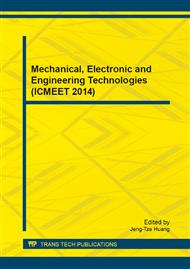p.348
p.352
p.356
p.360
p.367
p.371
p.375
p.379
p.383
The Trajectory Planning and Simulation for Industrial Robot Based on Fifth-Order B-Splines
Abstract:
The trajectory is planned with fifth-order uniform B-splines for the industrial robot aimed to assure the motion is smooth and the trajectory is fourth-order continuous. Under the premise to satisfy the initial kinematic parameters of the robot as zero, its speed, acceleration and jerk are continuous. Based on B-spline theory, process five B-spline curve function is calculated inversely in joint space. Under the robot kinematics parameter constraints, using fifth-order B-spline interpolates to plan robot trajectory when known interpolation points and the kinematic parameters are simulated and validated by the software of ADAMS.So it provides an effective new method for the trajectory planning.
Info:
Periodical:
Pages:
367-370
Citation:
Online since:
April 2014
Authors:
Keywords:
Price:
Сopyright:
© 2014 Trans Tech Publications Ltd. All Rights Reserved
Share:
Citation:


